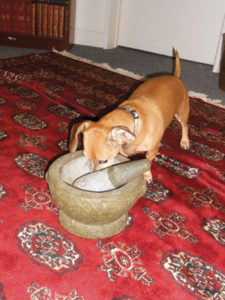
IC sent this photo of a very heavy, 9″ diameter stone mortar and pestle. I find it difficult to ascertain the age of this beauty. Mortar and pestles go back, in this country at least, to the early Native American cultures. The Mission San Buenaventura Museum displays a nice collection of ancient mortars, pestles and metates. I used to get lucky on archeological digs and found huge stone metates too large for me to lift myself.
How did Native Americans use a mortar and pestle?
The photos shows a granite duo. Since IC used to make herbal medicines with it, we need to clean it in the traditional way, by grinding raw rice.
A good cook uses hers to grind down whole spices, or peppercorns, to make basil pesto, guacamole, spice marinades, for flax seed in morning yogurt and to make curry pastes for Singaporean/Malaysian curries. She pounds fresh and dried chilies, garlic, shallots, ginger galangal, candlenuts and lemongrass all together to make a great curry. The cook makes nu tbutter, grinds the cat’s pill to hide it, peels garlic, and grinds sea salt down to tiny grains for her popcorn. Food processors cut. Mortars and pestles bruise beautifully, and are more fun to use.
This approximately 8000 year form must work
All these uses, except to pulverize the cat’s pill, are ancient uses. A myth from Thailand reads that a certain young woman elevated herself to the status of marrying the prince because of the rhythm of her pounding–expertly, without stopping, as only a real cook does. By the young woman’s constant rhythm, the prince knew her no-nonsense style which comes in handy in important rooms of the house!
Mortars and pestles throughout the ages are comprised of one of four types of materials:
- Metal: bronze for apothecary use, or zinc, cast iron, tin
- Stone: marble with a marble pestle, granite with a granite pestle;
- Ceramic: vitreous or porcelain
- Wood: the best of mortars are from the densest wood, Lignum Vitae (Latin: tree of life), indigenous to Jamaica and exported to Europe from the 16th century. All other woods used for mortars tend to house mold, not Lignum Vitae mortars.
In Mexican cooking a shallower mortar is called a Molcajete. Mortars have come in many sizes for so many uses. This one is 9″ in diameter and 6″ tall, machine finished inside and rough granite outside. Early forms are rectangular slabs of basaltic lava with a large cylindrical rolling pestle. Early apothecary mortar and pestles are usually bronze, and still today used as the universal symbol for “drug store.” IC’s is worth about $50, as it doesn’t appear antique. But it looks like a work of ancient art.
I inhrited a stone mortar and pestal that supposedly was inside a wall in Italy but was discovered when a building was bombed. Can you appraise its value for me?
For an appraisal please contact Elizabeth at (805) 895.5005 or elizabethappraisals@gmail.com
My family has in possession what looks to be a very primitive mortar with a handle. I have not found anything that looks like it. Whom could I contact to exchange photos?